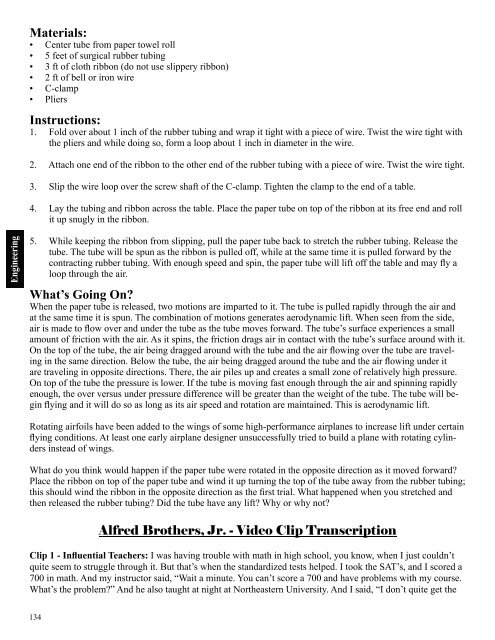ScienceMakers Toolkit Manual - The History Makers
ScienceMakers Toolkit Manual - The History Makers
ScienceMakers Toolkit Manual - The History Makers
You also want an ePaper? Increase the reach of your titles
YUMPU automatically turns print PDFs into web optimized ePapers that Google loves.
Engineering<br />
Materials:<br />
• Center tube from paper towel roll<br />
• 5 feet of surgical rubber tubing<br />
• 3 ft of cloth ribbon (do not use slippery ribbon)<br />
• 2 ft of bell or iron wire<br />
• C-clamp<br />
• Pliers<br />
Instructions:<br />
1. Fold over about 1 inch of the rubber tubing and wrap it tight with a piece of wire. Twist the wire tight with<br />
the pliers and while doing so, form a loop about 1 inch in diameter in the wire.<br />
2. Attach one end of the ribbon to the other end of the rubber tubing with a piece of wire. Twist the wire tight.<br />
3. Slip the wire loop over the screw shaft of the C-clamp. Tighten the clamp to the end of a table.<br />
4. Lay the tubing and ribbon across the table. Place the paper tube on top of the ribbon at its free end and roll<br />
it up snugly in the ribbon.<br />
5. While keeping the ribbon from slipping, pull the paper tube back to stretch the rubber tubing. Release the<br />
tube. <strong>The</strong> tube will be spun as the ribbon is pulled off, while at the same time it is pulled forward by the<br />
contracting rubber tubing. With enough speed and spin, the paper tube will lift off the table and may fl y a<br />
loop through the air.<br />
What’s Going On?<br />
When the paper tube is released, two motions are imparted to it. <strong>The</strong> tube is pulled rapidly through the air and<br />
at the same time it is spun. <strong>The</strong> combination of motions generates aerodynamic lift. When seen from the side,<br />
air is made to fl ow over and under the tube as the tube moves forward. <strong>The</strong> tube’s surface experiences a small<br />
amount of friction with the air. As it spins, the friction drags air in contact with the tube’s surface around with it.<br />
On the top of the tube, the air being dragged around with the tube and the air fl owing over the tube are traveling<br />
in the same direction. Below the tube, the air being dragged around the tube and the air fl owing under it<br />
are traveling in opposite directions. <strong>The</strong>re, the air piles up and creates a small zone of relatively high pressure.<br />
On top of the tube the pressure is lower. If the tube is moving fast enough through the air and spinning rapidly<br />
enough, the over versus under pressure difference will be greater than the weight of the tube. <strong>The</strong> tube will begin<br />
fl ying and it will do so as long as its air speed and rotation are maintained. This is aerodynamic lift.<br />
Rotating airfoils have been added to the wings of some high-performance airplanes to increase lift under certain<br />
fl ying conditions. At least one early airplane designer unsuccessfully tried to build a plane with rotating cylinders<br />
instead of wings.<br />
What do you think would happen if the paper tube were rotated in the opposite direction as it moved forward?<br />
Place the ribbon on top of the paper tube and wind it up turning the top of the tube away from the rubber tubing;<br />
this should wind the ribbon in the opposite direction as the fi rst trial. What happened when you stretched and<br />
then released the rubber tubing? Did the tube have any lift? Why or why not?<br />
134<br />
Alfred Brothers, Jr. - Video Clip Transcription<br />
Clip 1 - Infl uential Teachers: I was having trouble with math in high school, you know, when I just couldn’t<br />
quite seem to struggle through it. But that’s when the standardized tests helped. I took the SAT’s, and I scored a<br />
700 in math. And my instructor said, “Wait a minute. You can’t score a 700 and have problems with my course.<br />
What’s the problem?” And he also taught at night at Northeastern University. And I said, “I don’t quite get the










